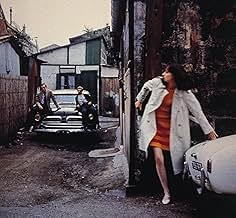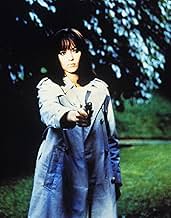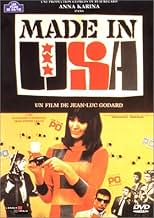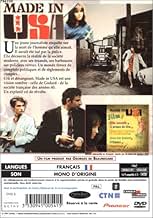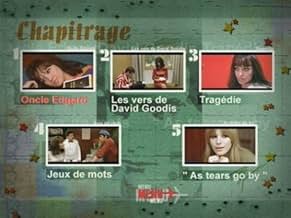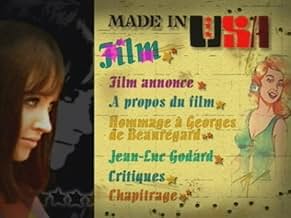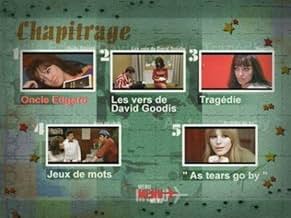In the near future, leftist writer Paula goes from Paris to the French town of Atlantic-Cité when she learns of the death of a former colleague and lover, Richard P. Is she there to investig... Read allIn the near future, leftist writer Paula goes from Paris to the French town of Atlantic-Cité when she learns of the death of a former colleague and lover, Richard P. Is she there to investigate? On the surface, faces are beautiful, colors bright, clothes trendy. Beneath, little i... Read allIn the near future, leftist writer Paula goes from Paris to the French town of Atlantic-Cité when she learns of the death of a former colleague and lover, Richard P. Is she there to investigate? On the surface, faces are beautiful, colors bright, clothes trendy. Beneath, little is clear: some talk to Paula as if she's Alice in Wonderland, corpses pile up, and ideologi... Read all
- Director
- Writers
- Stars
- Paula Nelson
- (as AK)
- Richard Widmark
- (as LS)
- Donald Siegel
- (as JPL)
- David Goodis
- (as YA)
- Man with Marianne Faithfull
- (uncredited)
- Policeman
- (uncredited)
- Richard Nixon
- (uncredited)
- Inspector Aldrich
- (uncredited)
- Bill Poster
- (uncredited)
- Barman
- (uncredited)
- Workman in bar
- (uncredited)
- Dental Assistant
- (uncredited)
- Richard Politzer
- (voice)
- (uncredited)
- Robert MacNamara
- (uncredited)
- Girl in Bandages
- (uncredited)
- Doris Mizoguchi
- (uncredited)
- Self
- (uncredited)
- Director
- Writers
- All cast & crew
- Production, box office & more at IMDbPro
Featured reviews
Paula (Anna Karina), a journalist, goes to a small town where her estranged boyfriend Richard has died in mysterious circumstances, surely murder. Determined to get to the bottom of things, she takes on the air of a hardboiled detective, wielding a pistol and wearing a Bogartian trenchcoat. She meets the doctor who did the autopsy and has a run-in with the police, but mainly we see her tangled up with two gangsters, played by László Szabó and Jean-Pierre Léaud.
Godard maintains just enough conventional dialogue and action to let the viewer know where we are in the crime novel's plot, but most of what transpires before the camera must be understood as only abstract metaphors for what would have happened in the book. The interaction between his characters mainly has other purposes. They have absurdist conversations with a great deal of wordplay. They allude to French politics in a time when Godard was worried about the compromised values of the French Left and the spectres of fascism and consumer society. The Ben Barka affair, where a Moroccan dissident was murdered in France in 1965 with the apparent involvement of the French security services, looms very large over MADE IN U.S.A., almost elbowing Westlake's original story out entirely. As if aware that he had stripped the plot down to such a degree that he now had too much time to be filled, he gives little asides like Marianne Faithful singing "Tears Go By" a cappella in a cameo and Kyôko Kosaka strumming a guitar and singing in Japanese.
This is not one of Godard's best films. For one, Godard reused many of the elements of his masterpiece PIERROT LE FOU from the year before. PIERROT LE FOU was itself assembled as sort of a collage of shots from Godard's prior films, which worked well as a wonderful summing up of his early career. But when he does the same with MADE IN U.S.A., it is to greatly diminished effect. But even if this is weak by Godard standards, it is nonetheless a moving experience. Shot in colour and in Cinemascope, this is a feast for the eyes. The very best of what the 1960s had to offer in terms of fashion and product design is on hand here and it just jumps of the screen. The image feels electric. (It is a pity that Criterion's edition is only on DVD, as a Blu-Ray would have yielded even greater pleasures.) Godard's longtime cameraman Raoul Coutard gives us some elaborate long takes that impress. And of course it's Godard's last major celebration of Anna Karina's beauty and poise, which really was something for the ages, still stunning half a century later.
Do not watch this movie late at night or while doing anything that will cause you to glance away from the screen. Every moment in this film is necessary, every word that Godard has our actors speak - while at times confusing and thought provoking - is needed to tell this dis-narrative story. Godard is a master behind the camera for this film - giving us an early glimpse as to what was in store with "Pierrot Le Fou", his bold color and well read characters (each one is always holding a book - Bravo!), are just the crust. What made "Made in USA" stand out was the obvious connections to Walt Disney, the "Big Sleep", and nearly everything coming out of the 60s in America, but what makes Godard impressive, is that one needs to search to see it. He doesn't spoon feed you a narrative that makes your heart gush at the end, Godard creates challenging cinema that will not be enjoyed by all, but if developed - if watched over time - if studied, remains important even 43 years later.
"Made in USA" is another Criterion release that looks and sounds perfectly, but - even with my discussion on how great Godard's work is - isn't the greatest release from the master. Yep, I am a Godard fan, but I am picky. I didn't enjoy "Breathless", but "Pierrot Le Fou" I hold very highly - and this - well, "Made in USA" is intelligent, but perhaps a bit too pretentious. The idea behind this film is solid, but it is the execution that had me nervous. Godard is eloquent in introducing us to certain characters and elements, but gives them names of his favorites like McNamara and Nixon that just feels weighted by symbolism and inside jokes. The viewing took place over the course of three days, not due to the diminishing subject, but because a rewind was needed to ensure that parts didn't go missing or lost. Crafting one part puzzle, one part social commentary, one part comedy is difficult - and for the beginning film watcher - this probably isn't the best film to first experience Godard. Here is what I liked - I loved not knowing. What was exhilarating about this feature was the unknown. The confusing dialogue, the menacing tape voice, the constant barrage of planes flying overhead (if that IS what that noise was), and the possible hope of knowing Richard's last name - keeps one wanting to finish, but getting there is a battle. The dialogue is either a love or hate moment. As there is no linear story, from the spoken perspective, and it is easy to get lost in Godard's cluttered words. For myself, it was at times refreshing - and at other times a disaster. Without a linear narrative, it was difficult to understand how one character fit within the scheme of events. What was happening between Paula and Mr. Typhus? Just thinking about it gives me a headache.
The scenes that stood out in this film were the bartender moments (where you could call him Paul or Bartender, but not "sir"), the pinball machine in the garage, and the billboard store room characters. These made me chuckle and see the humor that Godard was demonstrating, but the others just felt murky and disjointed. Again, I would like to state that every scene was necessary, but were they great? The imagery was spectacular - giving us the color palette that he would later use in "Pierrot Le Fou" - and the cinematography followed suit. For me, it was just the language the bogged me down. I wanted to know these characters further, I wanted to further know the story of the skulled man, and who was double crossing who. "Made in USA" is an important film, I am glad to see it within the Criterion catalogue, but it is an advanced film. The average film watcher will not like this movie, even I felt lost sometimes - but I am so very happy that I watched it.
In another review, this film was quoted as a "B-side" to the Godard cannon, and I couldn't agree more. Could I watch this movie again? Absolutely, but not right away. I look forward to re-exploring this piece of cinema, understanding what I missed, and seeing the inside moments that may have slipped by me the first time. "Made in America" isn't perfect, and I don't know anyone that can take a ten minutes of a tape playing discussing politics, but this self-proclaimed "B-side" finally has a release it deserves.
Grade: *** 1/2 out of *****
It seems the real inspiration behind this was the disappearance of a prominent Moroccan leftist leader in Paris, Ben Barka. One can imagine the scandal caused at the time, how much it said about France and the West, especially to someone like Godard who would be attuned to receive it.
The first thing to glean then is that instead of filming the outrage, the obscuring of truth and malaise, using fiction, Godard reverts back to image and cinema, about fiction. To that effect he plucks a potboiler story from a book about a woman who travels to a coastal town where her revolutionary lover has told her to meet him only to find him mysteriously dead, but instead of filming the mystery and noir conspiracy, Godard films a disjointed tapestry of image and citation.
There are many of these, quotes, abrupt cuts and insertions, ruminations on camera, agitprop played from tape-recorders, all first of course Godard's fooling with cinema to see what it is made of, but moreover his oblique way of delivering the obscuring of truth, the disjointed nature of living in a world where people can mysteriously disappear and we can only grasp at fictions. As more of an afterthought he can joke that this knot of indecipherable plot is his version of The Big Sleep.
More fascinating is what all this shows of Godard. There's a bourgeois intellectual in him, that side of him he would run away from after Weekend, who wants to present his view of a concave reality, but none of it deep, transformative or unsettling, always thinly exposing thin artifice. There's of course talk of Disney and Bogart, there's a Rue Preminger, an inspector Aldrich. Tarantino- isms.
But also a spiritual side of him, a burning desire to transcend the clutter of narratives and mind; at one point Anna Karina whispers about how she would rather have nothing instead of everything as a way of reaching the absolute, it's this absolute that likely he chased in the chimera of politics and beyond. He doesn't know yet that this nothingness is not only another thought or another belief but a cessation of thought, a suspension of disbelief. He would later.
It's this other Godard who is a gentle soul, contains the child fascinated by image, the poet fascinated by love, perhaps not the philosopher troubled by being which was only more thought stood in his way. This side is as stifled here, unable to pierce through the cutouts, as it was after Weekend when he wasted his talent in things like Pravda, and was only really let flourish in the 90s, his transcendent period when you must find him again.
Out of 100, I give it 71. That's good for ** out of ****.
Seen at home, in Toronto, on November 26th, 2002.
Did you know
- TriviaThough based on "The Jugger" by Richard Stark (Donald E. Westlake), the author received no compensation for this adaptation. Westlake, who passed away at the end of 2008, successfully kept the film from being shown in the US during his lifetime.
- Quotes
Marianne Faithfull: It is the evening of the day / I sit and watch the children play / Smiling faces I can see / But not for me / I sit and watch / As tears go by / My riches can't buy everything / I want to hear the children sing / All I hear is the sound / Of rain falling on the ground / I sit and watch / As tears go by / It is the evening of the day / I sit and watch the children play / Doing things I used to do / They think are new / I sit and watch / As tears go by
- ConnectionsEdited into Bande-annonce De 'Made in U.S.A.' (1966)
- SoundtracksAs Tears Go By
Written by Mick Jagger, Keith Richards and Andrew Loog Oldham
Performed by Marianne Faithfull
- How long is Made in U.S.A?Powered by Alexa
Details
Box office
- Budget
- $50,000 (estimated)
- Gross US & Canada
- $95,209
- Opening weekend US & Canada
- $11,147
- Jan 11, 2009
- Gross worldwide
- $95,304
- Runtime
- 1h 30m(90 min)
- Sound mix
- Aspect ratio
- 2.35 : 1


